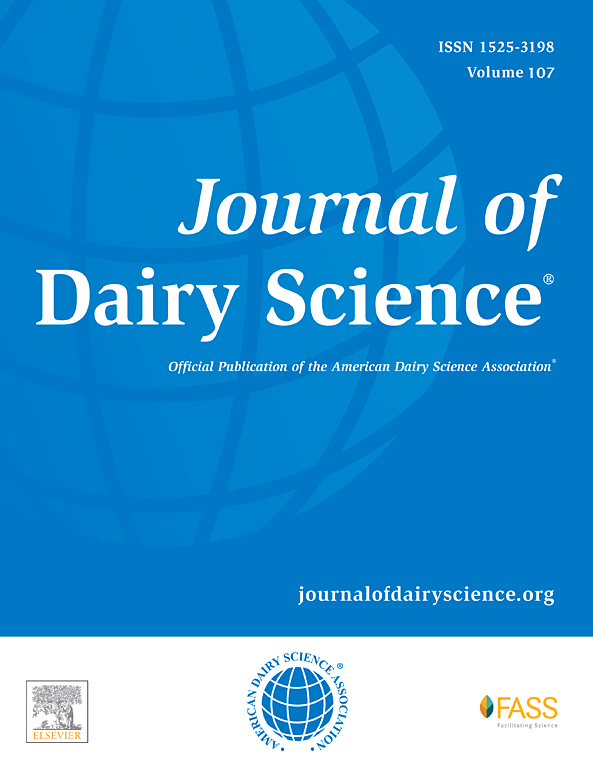过渡期奶牛产前肝谷胱甘肽及其与泌乳性能、代谢和健康结局的关系
摘要
我们的目的是确定过渡期奶牛产前肝脏谷胱甘肽(GSH)浓度与泌乳性能参数、代谢和炎症以及基因表达的关系。选取60头荷斯坦奶牛,于产犊期-21±3.3 d入组,持续试验至30 DIM。所有奶牛从-21 DIM至产犊期饲喂相同的近距离饲粮(1.67 Mcal/DM, 13.5% CP)和产犊期至30 DIM饲喂相同的泌乳饲粮(1.80 Mcal/DM, 17.7% CP)。所有奶牛在产犊后-8天(±3.2天)进行肝脏活检,并使用商用比色试剂盒测量总谷胱甘肽。该指标用于根据谷胱甘肽将奶牛回顾性分类为高(HGSH, n = 15)、中高(MHGSH, n = 15)、中低(MLGSH, n = 15)和低(LGSH, n = 15)。在-8、7和21 DIM时收集肝脏样本,在-21、-10、2、7、14和21 DIM时收集血液样本,以评估氧化应激、代谢、炎症和肝功能生物标志物。使用SAS (SAS Institute Inc., Cary, NC)的MIXED程序进行统计分析,并进行预先计划的对比,以检验GSH水平增加的线性效应。从LGSH组到HGSH组,产前能量平衡(EB,从-1.55 Mcal/d增加到1.11 Mcal/d)和产后BCS(从3.00 Mcal/d增加到3.16 Mcal/d)呈线性增加,提示产前肝GSH与分娩前后能量代谢有关。这种影响也与产前DMI呈线性增加的趋势有关,因为各组的肝GSH增加。我们观察到,随着产前肝GSH水平的增加,ECM(从50.2 kg/d增加到54.7 kg/d)和乳蛋白产量(从1.33 kg/d增加到1.46 kg/d)呈线性增加。通过铁还原抗氧化能力测定的活性氧代谢物和抗氧化能力均未因肝前GSH而改变。然而,血浆中总硫醇群随着预肝GSH的增加呈线性增加,提示有一定程度的抗氧化保护作用。随着肝前GSH水平的增加,肝脏中GSH的总量(从0.83到1.74 nmol/mg)呈线性增加,减少(从0.66到1.37 nmol/mg),氧化形式(从0.07到0.17 nmol/mg)。在-8 DIM时,MHGSH奶牛的肝脏g-谷氨酰转肽酶活性高于LGSH和HGSH。在-8 DIM时,GSH代谢相关基因(包括GCLC、GGCT和GSR)线性上调,提示本研究中观察到的GSH表型可能与转录调控有关。这些结果强调了产犊前维持足够的肝谷胱甘肽储备对支持代谢适应和泌乳性能的重要性。未来的研究应进一步探索谷胱甘肽对泌乳性能和氧化应激保护的直接影响,以及促进产犊前肝脏谷胱甘肽合成的营养和管理因素。Our objective was to determine the association of prepartal liver glutathione (GSH) concentration with lactation performance parameters, metabolism and inflammation, and gene expression in transition dairy cows. Sixty Holstein dairy cows were enrolled at -21 ± 3.3 d relative to calving and remained on trial until 30 DIM. All cows received the same close-up diet from -21 DIM until calving (1.67 Mcal/DM and 13.5% CP) and lactation diet from calving until 30 DIM (1.80 Mcal/DM and 17.7% CP). A liver biopsy was performed in all cows at -8 d (±3.2 d) relative to calving, and total GSH was measured using a commercial colorimetric kit. This metric was used to retrospectively classify cows by GSH as high (HGSH; n = 15), medium-high (MHGSH; n = 15), medium-low (MLGSH; n = 15), and low (LGSH; n = 15). Liver samples were collected at -8, 7, and 21 DIM, and blood samples at -21, -10, 2, 7, 14, and 21 DIM to evaluate oxidative stress, metabolism, inflammation, and liver function biomarkers. Statistical analysis was performed using the MIXED procedure of SAS (SAS Institute Inc., Cary, NC) with the preplanned contrast to test a linear effect with increasing levels of GSH. A linear increase in prepartal energy balance (EB; from -1.55 to 1.11 Mcal/d) and postpartal BCS (from 3.00 to 3.16) was observed as prepartal liver GSH increased from LGSH to HGSH groups, suggesting an association between prepartal liver GSH and energy metabolism around parturition. This effect was also associated with a trend for a linear increase in prepartal DMI as prepartal liver GSH increased across groups. We observed a linear increase in ECM (from 50.2 to 54.7 kg/d) and milk protein yield (from 1.33 to 1.46 kg/d) as prepartal liver GSH levels increased. Neither reactive oxygen metabolites nor antioxidant capacity measured via ferric reducing antioxidant power were altered according to prepartal liver GSH. However, there was a linear increase in the total thiol groups of plasma as prepartal liver GSH increased, suggesting some level of antioxidant protection. A linear increase in total (from 0.83 to 1.74 nmol/mg), reduced (from 0.66 to 1.37 nmol/mg), and oxidized forms of GSH (from 0.07 to 0.17 nmol/mg) was observed in the liver as prepartal liver GSH levels increased. The hepatic activity of g-glutamyl transpeptidase at -8 DIM was greater in MHGSH cows compared with LGSH and HGSH. At -8 DIM, a linear upregulation of genes related to GSH metabolism, including GCLC, GGCT, and GSR, was observed as prepartal liver GSH increased, suggesting that transcriptional regulation may contribute to the GSH phenotype observed in this study. These results emphasize the importance of maintaining adequate hepatic GSH reserves before calving to support metabolic adaptation and lactation performance. Future research should explore the direct effect of GSH on lactation performance and oxidative stress protection, as well as nutritional and management factors to enhance hepatic GSH synthesis before calving.

 求助内容:
求助内容: 应助结果提醒方式:
应助结果提醒方式:


